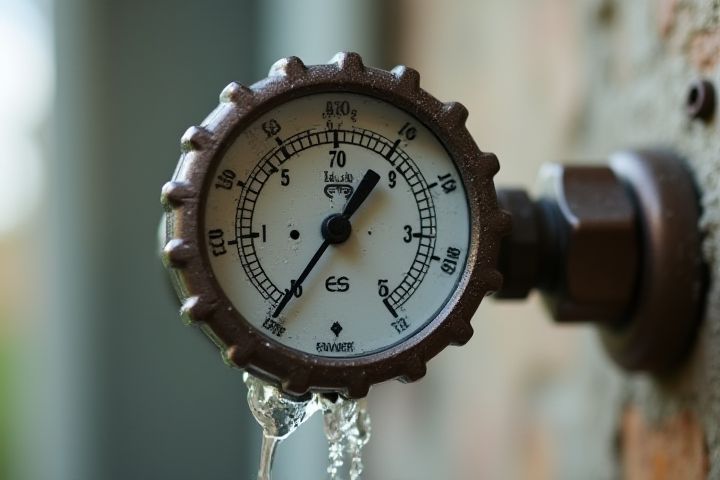
Low water pressure in your house can stem from various factors. Clogged pipes, often due to mineral buildup or debris, hinder water flow significantly. A malfunctioning pressure regulator, responsible for maintaining optimal pressure levels, may also be the culprit. Additionally, leaks in the plumbing system can lead to a substantial drop in pressure, wasting water and causing further damage. To resolve these issues, consider conducting regular maintenance checks or consulting a professional plumber.
Why House Has Low Water Pressure
Clogged pipes
Clogged pipes are a common culprit behind low water pressure in houses, as they restrict the flow of water throughout the plumbing system. Over time, debris, mineral buildup, or even grease can accumulate within the pipes, creating blockages that hinder water movement. If you notice a significant drop in pressure, inspecting your pipes for clogs can reveal the issue. Regular maintenance and timely cleaning of your plumbing can help prevent these blockages, ensuring a consistent and adequate water flow in your home.
Partially closed shut-off valves
Partially closed shut-off valves are a common cause of low water pressure in your home, as they restrict the flow of water throughout the plumbing system. When these valves are not fully open, they create bottlenecks that hinder water movement, resulting in diminished pressure at faucets and fixtures. Over time, sediment buildup or improper adjustments can lead to this issue, affecting the overall performance of your plumbing. Regularly checking and ensuring that all shut-off valves are fully open can help maintain optimal water pressure for your household needs.
Faulty pressure regulator
A faulty pressure regulator can significantly contribute to low water pressure in your house, often resulting in frustrating shower experiences and inefficient appliance operation. Typically, a pressure regulator maintains water pressure within a designated range, usually between 40-60 psi; when it malfunctions, it can either drop below this threshold or fail to regulate pressure adequately. This malfunction may stem from factors such as wear and tear, debris buildup, or incorrect installation, ultimately limiting the flow of water throughout your plumbing system. Regular inspections and timely replacements of your pressure regulator can ensure optimal water pressure, enhancing your overall water use experience.
Corroded plumbing
Corroded plumbing is a common cause of low water pressure in households. Over time, mineral buildup and rust can accumulate inside pipes, reducing the diameter and impeding water flow. This corrosion often affects older metal pipes, leading to leaks and further pressure drops. If you notice diminished water pressure, inspecting your plumbing system for corrosion is essential to ensure consistent water delivery throughout your home.
Leaking pipes
Leaking pipes significantly contribute to low water pressure in your home, as these leaks divert essential water flow away from your fixtures. Over time, deterioration from corrosion, tree roots, or wear can create small holes or cracks in your plumbing, leading to substantial water loss. The reduction in available water for your taps, shower, or appliances results in inadequate pressure. Addressing these leaks promptly is crucial to restoring optimal water pressure and preventing further damage to your plumbing system.
Municipal water supply issues
Low water pressure in houses is often attributed to municipal water supply issues, which can stem from inadequate infrastructure or outdated piping systems. Aging pipelines may experience corrosion or blockages, reducing the effective flow of water to your home. Additionally, high demand during peak usage times can lead to decreased water pressure, especially in areas with insufficient reservoir capacity. Understanding these municipal factors is essential for homeowners seeking to address low water pressure problems effectively.
Malfunctioning water softener
A malfunctioning water softener can significantly contribute to low water pressure in your home. If the resin beads inside the softener become clogged with debris or scale buildup, they can impede water flow, resulting in reduced pressure. Additionally, a faulty bypass valve may prevent the water softener from effectively treating water, leading to untreated hard water entering your plumbing system and further complicating pressure issues. Regular maintenance and timely repairs of your water softener can help maintain optimal water pressure and overall plumbing efficiency.
Blocked aerators or showerheads
Low water pressure in your house can often be attributed to blocked aerators or showerheads, which restrict water flow and degrade overall performance. Over time, mineral deposits and sediment can accumulate in these fixtures, leading to diminished water output. Regularly cleaning or replacing aerators and showerheads can significantly improve your water pressure and enhance your bathing experience. Ensuring your plumbing system remains free of blockages is essential for maintaining optimal water flow throughout your home.
High demand periods
Low water pressure in your house often becomes a significant issue during high-demand periods, such as morning routines when multiple fixtures are in use simultaneously. Typical household water pressure ranges between 40 to 60 psi, but during peak usage times, this pressure can drop dramatically due to increased consumption from showers, faucets, and appliances. Municipal water systems may struggle to provide adequate flow when service demands exceed available supply, especially in densely populated areas. A pressure-reducing valve or a water tank can help mitigate these fluctuations, ensuring a more consistent supply during high-demand hours.
Broken water pump
Low water pressure in your house can often stem from a broken water pump, which is crucial for regulating water flow throughout your plumbing system. When the pump malfunctions, it may fail to generate the necessary pressure, leading to diminished water supply in faucets and showerheads. In many cases, water pumps have a lifespan of around 10 to 15 years, after which they may require replacement or repair. Regular inspections are essential; a broken pump can not only affect your water pressure but can also lead to more significant plumbing issues if not addressed promptly.
